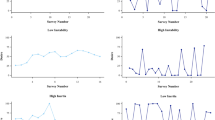Abstract
The present investigation examined the relationship between affect and pulse rate (PR) change for individuals with different sensation-seeking preferences. Based on their scores on the Sensation-Seeking Scale (Zuckerman, Kolin, Price, & Zoob, 1964), high (HSS) and low (LSS) sensation-seekers were assigned randomly to either 40 minutes of feedback or nofeedback in PR. Subjects were instructed either to decrease or to increase PR. Measures of affect were administered after the 40-minute period. The results indicated that while feedback caused subjects to change PR in either direction, HSS subjects were more successful at increasing, while LSS subjects were more successful at decreasing. Moreover, negative affect resulted only when HSS subjects decreased and LSS subjects increased PR. The results are discussed in terms of the importance of considering individual differences in preference for activation in order to clarify the relationship between physiological and affective responses.
Similar content being viewed by others
References
Bell, I. R., & Schwartz, G. E. Voluntary control and reactivity of human heart rate.Psychophysiology 1975,12 339–348.
Bloom, L. J., Houston, B. K., & Barish, T. G. An evaluation of finger pulse volume as a psychophysiological measure of anxiety.Psychophysiology 1976,13 40–42.
Clements, P. R., Hafer, M. D., & Vermillion, M. E. Psychometric, diurnal, and electrophysiological correlates of activation.Journal of Personality and Social Psychology 1976,33 387–394.
Cofer, C. N., & Appley, M. H.Motivation: Theory and research. New York: Wiley, 1964.
Cronbach, L. J., & Furby, L. How should we measure “change”—or should we?Psychological Bulletin 1970,74 68–80.
Duffy, E. Activation. In N. Greenfield & R. Sternbach (Eds.),Handbook of psychophysiology. New York: Holt, Rinehart & Winston, 1972.
Engel, B. T. Operant conditioning of cardiac function: A status report.Psychophysiology 1972,9 161–177.
Engel, B. T. Operant conditioning of cardiovascular function: A behavioral analysis. In S. Richman (Ed.),Contributions to medical psychology. Oxford: Pergamon Press, 1977. pp. 75–90.
Engel, B. T., & Gottlieb, S. H. Differential operant conditioning of heart rate in the restrained monkey.Journal of Comparative and Physiological Psychology 1970,73 217–225.
Folkins, C. H., Lawson, K. D., Opton, E. M., & Lazarus, R. S. Desensitization and the experimental reduction of threat.Journal of Abnormal Psychology 1968,73 100–113.
Geisser, S., & Greenhouse, S. W. An extension of Box's results on the use of theF distribution in multivariate analysis.Annals of Mathematical Statistics 1958,29 885–891.
Hodges, W. F. The psychophysiology of anxiety. In M. Zuckerman & C. D. Spielberger (Eds.),Emotions and anxiety: New concepts, methods, and applications. New York: Wiley, 1976.
Katz, H., Cadoret, R., Hughes, K., & Abbey, D. Physiological correlates of acceptable and unacceptable attitude statements.Psychological Reports 1965,17 78.
Krause, M. S. The measurement of transitory anxiety.Psychological Review 1961,68 178–189.
Lacey, J. I. The evaluation of autonomic responses: Toward a general solution.Annals of the New York Academy of Sciences 1956,67 123–164.
Lacey, J. I. Psychophysiological approaches to the evaluation of psychotherapeutic process and outcome. In E. A. Rubinstein & M. B. Parloff (Eds.),Research in psychotherapy. Washington, D.C.: American Psychological Association, 1959.
Lacey, J. I. Somatic response patterning and stress: Some revisions of activation theory. In M. H. Appley & R. Trumbull (Eds.),Psychological stress: Issues in research. New York: Appleton, 1967. pp. 14–42.
Lacey, J. I. Kagan, J., Lacey, B. C., & Moss, H. A. The visceral level: Situational determinants and behavioral correlates of autonomic response patterns. In P. H. Knapp (Ed.),Expression of the emotions in man. New York: International Universities Press, 1963. pp. 161–196.
Lacey, J. I., & Lacey, B. C. Verification and extension of the principle of autonomic response-stereotypy.American Journal of Psychology 1958,71 50–73.
Lang, P. J. Learned control of human heart rate in a computer directed environment. In P. A. Obrist, A. H. Black, J. Brener, & L. V. DiCara (Eds.),Cardiovascular psychophysiology: Response mechanisms, biofeedback and methodology. Chicago: Aldine, 1974, pp. 392–405.
Maddi, S. R.Personality theories: A comparative analysis. Homewood, Illinois: Dorsey Press, 1972.
Martin, B. The assessment of anxiety by physiological behavioral measures.Psychological Bulletin 1961,58 234–255.
Meichenbaum, D. Toward a cognitive theory of self-control. In G. Schwartz & D. Shapiro (Eds.),Consciousness and self-regulation: Advances in research. New York: Plenum Press, 1975.
Schachter, S., & Singer, J. E. Cognitive, social, and physiological determinants of emotional state.Psychological Review 1962,69 379–399.
Selye, H.Stress without distress. Philadelphia: J. B. Lippincott, 1974.
Spielberger, C. D. Anxiety as an emotional state. In C. D. Spielberger (Ed.),Anxiety: Current trends in theory and research (Vol. 1). New York: Academic Press, 1972.
Thayer, R. E. Measurement of activation through self-report.Psychological Reports 1967,20 663–678.
Wilder, J. Basimetric approach (law of initial value) to biological rhythms.Annals of the New York Academy of Sciences 1962,98 1211–1220.
Zuckerman, M. The development of an Affect Adjective Check List for the measurement of anxiety.Journal of Consulting Psychology 1960,24 457–462.
Zuckerman, M., Bone, R. N., Neary, R., Mangelsdorff, D., & Brustman, B. What is the sensation seeker? Personality trait and experience correlates of the Sensation-Seeking Scales.Journal of Consulting and Clinical Psychology 1972,39 308–321.
Zuckerman, M., Kolin, E. A., Price, L. & Zoob, I. Development of a sensation-seeking scale.Journal of Consulting Psychology 1964,28 477–482.
Author information
Authors and Affiliations
Rights and permissions
About this article
Cite this article
Stern, G.S., Cox, J. & Shahan, D. Feedback in pulse rate change and divergent affective reactions for high and low sensation-seekers. Biofeedback and Self-Regulation 6, 315–326 (1981). https://doi.org/10.1007/BF01000657
Issue Date:
DOI: https://doi.org/10.1007/BF01000657




